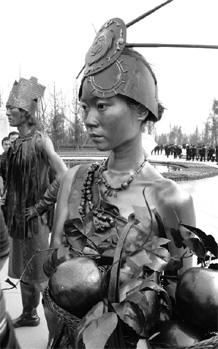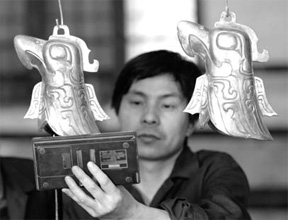Unearthing the past
|
|
|
The country's oldest and most intact jade outfit from the Han Dynasty is displayed at the Xuzhou Museum, Jiangsu province. [Photo: China Daily] |
A 5-hour train ride takes travelers from Beijing to Xuzhou, at the northern end of Jiangsu province. Archaeologists have discovered 18 grand mausoleums dating back to the Han Dynasty (202 BC-AD 220) in the city, hometown of Han Dynasty founder, Liu Bang.
|
|
|
Actors dress up as ancient residents of Sanxingdui at the museum in Guanghan, Sichuan province. [Photo: China Daily] |
Liu sent his younger brother Liu Jiao back to Xuzhou to become the Prince of Chu. In the Western Han Dynasty (202 BC-AD 9), 12 generations of princes ruled the territory.
Among the 18 mausoleums discovered, two have become the city's name cards - the final resting places of Liu Zhu at Guishan Hill and another prince at Shizi Hill.
Guishan, or Tortoise Hill, rises in the suburbs of Xuzhou. The mausoleum is so famous that an article by teacher Yu Yongzheng, on his journey into the ancient tomb, was selected into the Chinese textbook for the country's primary schools in 2005.
The mausoleum's discovery can be traced back to 1972, when people from the nearby Gushan village dynamited part of the hill to quarry its rocks.
They found a vertical tunnel and sent some brave villagers down to explore. They emerged with a dozen jade pieces.
The Xuzhou Cultural Relics Bureau immediately sent experts to study the site and learned that the owner of the tomb was Western Han Dynasty princess Bingchang.
Experts were enthusiastic about the discovery, which suggested her father's tomb would be nearby.
But it wasn't until a decade later that villagers - again quarrying - discovered the massive mausoleum.
Few relics were left in the prince's tomb, so experts debated over its occupant's identity for more than a year.
Some believed it was Liu Zhu, known as Prince Xiangwang of Chu. Others said it was Liu Chun, or Prince Jiewang.
In the end, it was a young boy who resolved the mystery.
At that time, the mausoleum was loosely guarded. Villagers came to watch the excavation and occasionally took souvenirs. The youth found a silver seal, which he wore as an amulet.
|
|
|
Researchers test the sound of a set of eagle head-shaped bell replicas found at Sanxingdui Ruins.[Photo: China Daily] |
His parents turned the seal over during the national cultural relics survey of 1982, leading to the consensus that the mausoleum was Liu Zhu's. Today, the seal and other artifacts are on display at the museum, which is built at the tomb's entrance.
The 56-m-long passageway empties into the main chamber for Liu Zhu and his wife. A red laser beam shoots out of the chamber through the channel - not for security reasons but rather to show visitors how straight the channel is.
As early as the Han Dynasty, thieves had broken into the tomb through the northern tunnel. Luckily, they didn't destroy the southern tunnel.
Ironically, experts found an inscription on a rock in the southern tunnel that says the prince followed the emperor's call to be thrifty in preparing the mausoleum, so there was nothing valuable inside.
The mausoleum has 15 chambers, covering about 700 sq m. In addition to a special chamber for the prince's favorite chariot, he also had asked for a kitchen, a storage room, a weaponry display room, a song-and-dance hall and even a meticulously built bathroom.
But while Liu Zhu's tomb is relatively devoid of treasures, the nearby Shizhi (Lion) Hill mausoleum, discovered in 1994, is loaded with some 2,000 priceless relics.
Among these, the jade attire threaded with gold is the most valuable.
Ancient Chinese rulers adored jade, believing the special stone could connect them with heaven. In the Han Dynasty, many emperors and princes wrapped themselves with jade robes when they died.
Among the seven Han Dynasty jade outfits found across the country, Shizhi Hill's is the best preserved and oldest.
Fortunately, ancient tomb raiders only valued the gold thread. When they extracted the gold, most of the jade pieces crashed to the ground. It took archaeologists some 22 months to rethread the 4,248 jade pieces. The bits vary from 9 to 1 sq cm in size and are in squares, triangles, circles and crescent shapes.
Today, this jade outfit is displayed at the Xuzhou Museum.
Sixteen years after its discovery, historians are still arguing about its occupant's identity. The most likely candidates are Liu Ying, the second Prince of Chu, and Liu Wu, his successor.
The mausoleum's discovery resulted from another astounding find in 1984, when a brick quarry uncovered several terracotta figurines. Although the Han Dynasty terracotta figurines are not as incredibly crafted as the Qin Dynasty (221-206 BC) Terracotta Warriors in Xi'an, Shaanxi province, they carry vivid and varied expressions.
Seasoned archaeologist Wang Kai believed the figurines were sacrificial offerings for an important prince. He searched far and wide. In 1991, he heard from an old farmer that the family had found some strange white clay when digging a cellar to store vegetables.
Wang and other experts dug further and were amazed to find that the entire Shizi Hill had been hollowed out for an 850-sq-m mausoleum covering 12 chambers. It must have taken ancient builders about 20 years to finish.
 0
0 











Go to Forum >>0 Comments